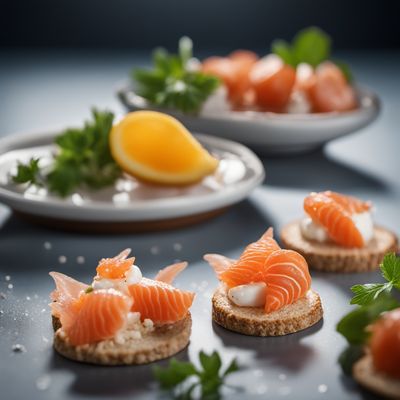
Ingredient
Finger food
Bite-Sized Delights: Exploring the World of Finger Food
Finger food encompasses a wide range of dishes, from simple and familiar classics like chicken wings and sliders to more elaborate and gourmet creations like bruschetta and sushi rolls. The beauty of finger food lies in its versatility, as it can be customized to suit different tastes and dietary preferences. The texture and appearance of finger food can vary greatly depending on the specific dish, ranging from crispy and crunchy to soft and creamy.
Origins and history
The concept of finger food can be traced back to ancient times, where it was common to serve small, handheld snacks during social gatherings or feasts. Over the centuries, finger food has evolved and adapted to different cultures and cuisines, becoming an integral part of culinary traditions around the world. Today, finger food is enjoyed globally and has become a staple at parties, events, and even in casual dining establishments.
Nutritional information
The nutritional content of finger food can vary greatly depending on the specific dish and ingredients used. While some finger foods may be high in calories, fat, or sodium, others can be nutrient-dense and provide a good balance of macronutrients and micronutrients. It is important to choose a variety of finger foods that offer both indulgence and nutritional value, and to consume them in moderation as part of a balanced diet.
Allergens
Finger food may contain allergens such as gluten, dairy, nuts, or shellfish, depending on the specific dish and ingredients used. It is important to consider the dietary restrictions and allergies of guests when planning a menu for a gathering or event. Providing a variety of options and clearly labeling allergens can help ensure the safety and enjoyment of all attendees.
How to select
When selecting or preparing finger food, consider the occasion, theme, and dietary preferences of the guests. Choose a variety of dishes that offer a balance of flavors, textures, and presentations. Opt for fresh, high-quality ingredients and pay attention to food safety practices to ensure the safety and enjoyment of the food.
Storage recommendations
To maintain the freshness and quality of finger food, store them in airtight containers or covered platters in the refrigerator. Some finger foods may need to be kept chilled until serving, while others can be served at room temperature. Follow specific storage instructions provided for each dish to ensure optimal taste and safety.
How to produce
Finger food can be produced by preparing bite-sized portions of various dishes or by creating specific recipes that are designed to be eaten with the fingers. The key is to focus on creating small, manageable portions that can be easily picked up and enjoyed without the need for utensils. Experiment with different ingredients, flavors, and presentations to create a diverse and exciting spread of finger food.
Preparation tips
When preparing finger food, consider the balance of flavors, textures, and colors to create an appealing and well-rounded menu. Incorporate a variety of ingredients such as vegetables, meats, cheeses, and breads to provide a diverse range of tastes and textures. Pay attention to presentation, using garnishes, sauces, or dips to enhance the visual appeal of the finger food. Provide small plates, napkins, and toothpicks or skewers for easy handling and enjoyment.
Culinary uses
Finger food is incredibly versatile and can be used in a wide range of settings and occasions. It is commonly served at parties, weddings, cocktail receptions, and corporate events as a way to offer guests a variety of flavors and options. Finger food can also be enjoyed as a casual meal or snack, either at home or in casual dining establishments. Its convenience and versatility make it a popular choice for individuals of all ages and backgrounds.
Availability
Finger food is available worldwide, as it is a concept that transcends cultural boundaries. However, the specific types of finger food and their popularity may vary depending on the region or country. Each culture has its own unique selection of finger foods that reflect its culinary traditions and local ingredients. From samosas in India to tapas in Spain, finger food can be found in various cuisines around the globe.
More ingredients from this category

Spring rolls
Delicate Wrappers of Freshness: Exploring the World of Spring Rolls

Fish-based canapé
The Elegant Seafood Bite

Filled canapé
Bite-sized Delights: Exploring the World of Filled Canapés

Sausage roll
"Savory Delight: The Perfect Sausage Roll"

Vol au vent
"Puff Pastry Delights: Exploring the Versatility of Vol au Vent"

Cheese-based canapé
Savory Bites of Cheesy Delight

Meat-based canapé
Savory Delights

Egg-based canapé
Savory Delights

Mushroom crostini
Savory Delights: Exploring the World of Mushroom Crostini